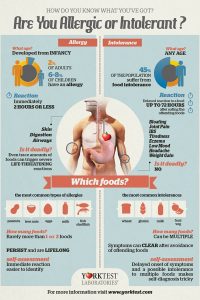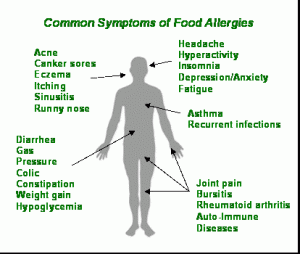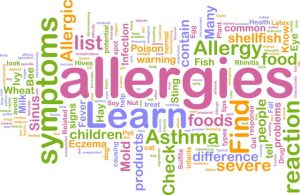Food Allergy Awareness Week: Are you Allergic or Intolerant?
Many times people mistake Intolerance for Allergy and vice versa. Please note that I have no affiliation with FARE or Foodallergy.org and that all opinions in this post are mine. I have recieved no compensation for any information provided and some information belongs to the owners/ writers of the foodallergy.org website or other websites found through research on the internet.
Symptoms
An allergic reaction to food can affect the skin, the gastrointestinal tract, the respiratory tract, and, in the most serious cases, the cardiovascular system. Reactions can range from mild to severe, including the potentially life-threatening condition known as anaphylaxis. In the U.S., food allergy symptoms send someone to the emergency room every three minutes.
Symptoms typically appear within minutes to several hours after eating the food to which you are allergic. Keep in mind that children may communicate their symptoms in a different manner than adults.
Mild symptoms may include one or more of the following:
- Hives (reddish, swollen, itchy areas on the skin)
- Eczema (a persistent dry, itchy rash)
- Redness of the skin or around the eyes
- Itchy mouth or ear canal
- Nausea or vomiting
- Diarrhea
- Stomach pain
- Nasal congestion or a runny nose
- Sneezing
- Slight, dry cough
- Odd taste in mouth
- Uterine contractions
Severe symptoms may include one or more of the following:
- Obstructive swelling of the lips, tongue, and/or throat
- Trouble swallowing
- Shortness of breath or wheezing
- Turning blue
- Drop in blood pressure (feeling faint, confused, weak, passing out)
- Loss of consciousness
- Chest pain
- A weak or “thread” pulse
- Sense of “impending doom”
Severe symptoms, alone or in combination with milder symptoms, may be signs of anaphylaxis and require immediate treatment.
How a Child Might Describe a Reaction
Children have unique ways of describing their experiences and perceptions, and allergic reactions are no exception. Precious time is lost when adults do not immediately recognize that a reaction is occurring or don’t understand what a child is telling them.
Some children, especially very young ones, put their hands in their mouths or pull or scratch at their tongues in response to a reaction. Also, children’s voices may change (e.g., become hoarse or squeaky), and they may slur their words.
The following are examples of the words a child might use to describe a reaction:
- “This food is too spicy.”
- “My tongue is hot [or burning].”
- “It feels like something’s poking my tongue.”
- “My tongue [or mouth] is tingling [or burning].”
- “My tongue [or mouth] itches.”
- “It [my tongue] feels like there is hair on it.”
- “My mouth feels funny.”
- “There’s a frog in my throat.”
- “There’s something stuck in my throat.”
- “My tongue feels full [or heavy].”
- “My lips feel tight.”
- “It feels like there are bugs in there.” (to describe itchy ears)
- “It [my throat] feels thick.”
- “It feels like a bump is on the back of my tongue [throat].”
If you suspect that your child is having an allergic reaction, follow your doctor’s instructions and treat the reaction quickly.
Treatment & Managing Reactions
Currently, the only way to prevent a food-allergic reaction is to avoid the problem food.
Once you have been diagnosed with a food allergy, talk to your doctor about how allergic reactions should be treated. Have your doctor create a written Food Allergy & Anaphylaxis Emergency Care Plan so that you and others will know what to do in the event of a reaction.
Mild to moderate symptoms (e.g., itching, sneezing, hives and rashes) are often treated with antihistamines and oral or topical steroids.
For patients at risk of experiencing a severe reaction (anaphylaxis), epinephrine is prescribed. Epinephrine is the only medication that can reverse the symptoms of anaphylaxis. If prescribed, use epinephrine at the first sign of an allergic reaction and call 911. Request an ambulance and tell the dispatchers that you have just used epinephrine for a suspected food-induced anaphylactic reaction. Patients should always go to the emergency room for further treatment, even if symptoms appear to resolve after epinephrine is administered.
Epinephrine is a safe drug, with the risks of anaphylaxis outweighing any risks of administering the medication. Extra caution is only needed for elderly patients or those with known heart disease where an increased heart rate could be problematic. Nonetheless, epinephrine should be used to treat anaphylaxis in these individuals. Patients should proceed to the emergency room after epinephrine is administered in case additional medication or treatment is needed to manage the reaction, not because epinephrine is a dangerous drug.
Once epinephrine is administered, other medications also may be used to control the reaction:
Steroids (e.g., cortisone) may be given, typically in the emergency room, to help reduce inflammation after an anaphylactic attack. Although steroids do not work fast enough for emergency treatment, they may help prevent a recurrence after the initial reaction has been treated.
Antihistamines, known as H1 blockers, are prescribed to relieve mild allergy symptoms, although they cannot control a severe reaction. Medications in this class include diphendydramine (Benadryl®) and cetirizine (Zyrtec®). An antihistamine should never be given as a substitute for epinephrine.
Asthma Medications. Short-acting bronchodilators (known as “rescue” inhalers), such as albuterol (Alupent®, Proventil®, Ventolin®), may be used to help relieve breathing problems once epinephrine has been given, particularly if you are experiencing asthma symptoms. They should not be depended upon to treat the breathing problems that can occur during anaphylaxis—use the epinephrine.
Be Prepared…Be Safe
An effective food allergy treatment plan includes all of the following:
- Strict avoidance of problem foods
- Working with your doctor to develop a Food Allergy Emergency Care Plan
- Wearing emergency medical identification (e.g., bracelet, other jewelry) at all times
- Carrying your medication wherever you go
- Taking your medication at the first sign of a reaction
- Getting to an emergency room for follow-up treatment if you have a severe reaction



Leave a Reply